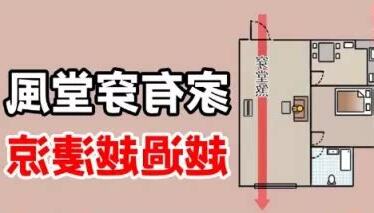引言:
自古即有堪輿之術,「堪輿」二字指的就是宅邸的坐向與周邊環境關係性的統稱,包含了地勢、山系、水紋等探討。風水之説長久以來影響著華人對空間設計的看法,這門學問,簡而言之就是古時的「室內設計學」。然而,今日的住宅格局、空間都與古時大相逕庭,究竟要如何以現代科學眼光看待居家風水禁忌?又該怎麼運用空間設計手法,才能更符合現代觀的風水?風水是華人的千年智慧,藏風納氣、風生水起,人與家宅、空間相互影響。從現代科學看風水,不論帶動氣流的「動線」、或是傢俱及裝潢創造的「視線」等,幾乎一切格局的安排,都是為了能良好地藏風納氣、創造安適的住宅空間。
在以往的居家風水中,最忌諱的是穿堂風。大門是進財的關鍵,若受到穿堂風的影響,將會導致財運不佳。因此,在現代空間設計中,我們必須思考如何避免穿堂風的問題,以創造一個繁榮與舒適的家居環境。


居家風水禁忌:穿堂煞的現代觀
自古以來,華人世界即有堪輿之術,風水學更是長久以來影響著空間設計的觀點。穿堂煞作為風水忌諱之一,指的是居家大門與後門或窗户直接相對的格局,這種佈局被認為會導致財氣外漏,不利於家庭的財運和氣場穩定。然而,隨著時代變遷和科學觀點的介入,我們可以如何重新看待這類風水禁忌,並運用現代設計手法進行調整呢?
穿堂煞的成因與影響
ancient times, feng shui has been an important part of Chinese culture, influencing various aspects of life, particularly in the selection and design of residential and commercial spaces. The term “feng shui” encompasses the study of the relationship between a building’s orientation and the surrounding environment, including elements such as topography, mountain ranges, and water patterns. This ancient discipline, in essence, can be likened to the field of interior design from a modern perspective. However, with the evolution of architectural styles and the changing spatial arrangements of modern times, the question arises: how can we understand and apply feng shui principles in the context of contemporary science and design?
In traditional feng shui, one of the most auspicious aspects is the prevention of the ‘through-tired wind’ or ‘chuan tang sha’ in Chinese. This refers to a layout where the main entrance and the rear or side exit are directly aligned, or where the front door faces a large window or multiple windows without any obstructions. Such a configuration is akin to a hole in a pocket, allowing money to flow in and out without retention, according to feng shui beliefs. Modern apartment buildings and studio apartments often face this challenge due to space constraints, leading to layouts where the front door is directly opposite a large window or where the living space is designed with few or no partitions, potentially resulting inThrough-tired wind conditions.

Scientifically speaking, a direct path for air to flow through a residence can enhance ventilation but can also lead to a draft that makes the space cooler and less insulated, particularly in winter or at night, potentially causing discomfort or even health issues. Additionally, the forceful airflow can cause doors to slam shut loudly, which may be startling, especially for the elderly and children.
To mitigate the effects of through-tired wind in a living space, strategic adjustments can be made within the design. If space permits, repositioning one of the doors or windows to avoid a direct line of sight can help create a more dynamic flow of air. Another option is to introduce a visual and physical barrier, such as a solid screen or a false wall, to create a transitional space between the entrance and the rest of the house, thereby disrupting the straight line of the through-tired wind. These design elements not only address feng shui concerns but also contribute to a more comfortable and aesthetically pleasing living environment.
當風從窗户中吹過,撲面而來的清新空氣,穿堂而過。這種風被稱為「穿堂風」,取自它能夠穿越建築物內部的走廊而來的特點。
穿堂風可能是在居民住宅或商業建築中最受歡迎的元素之一,因為它為人們帶來了許多好處。
首先,穿堂風提供了室內空氣的循環,進一步增加了房間的通風效果。這對於保持室內空氣的新鮮和乾燥非常重要,尤其是在潮濕的天氣或者長時間的封閉環境中。
穿堂風可以排除悶熱和潮濕感,讓人們感到舒適和放鬆。
其次,穿堂風還可以幫助平衡室內空氣的温度。在炎熱的夏季,風從窗户吹來,為整個房間帶來一絲涼爽。
這對於沒有空調設備或者希望節省能源的人們來説尤為重要。
此外,穿堂風還能夠幫助在冬季保持室內的温暖,因為風從窗户吹來時,它會帶走一部分冷空氣,同時讓更多的暖空氣滲透進來。
然而,穿堂風並不是完美的。有些人可能對風的強度感到不舒服,尤其是當它變得過於強勁時。
此外,穿堂風也可能吹來灰塵和細菌,這對於對環境敏感或有呼吸道問題的人不利。
因此,在設計建築物時,必須注意控制穿堂風的強度和方向,以確保人們的舒適和健康。
總之,穿堂風是一個廣受歡迎的設計元素,對於提供良好的室內空氣品質和舒適的環境至關重要。
無論是在家庭還是商業環境中,穿堂風都可以為人們帶來許多好處,從增加通風效果到平衡室內温度。
關鍵是確保穿堂風的適度和控制,以確保人們的健康和舒適。
延伸閲讀…
家有穿堂風,越過越淒涼!如何化解才最佳?#大佬你好啊
什麼是「穿堂煞」? 要如何化解? | homify
